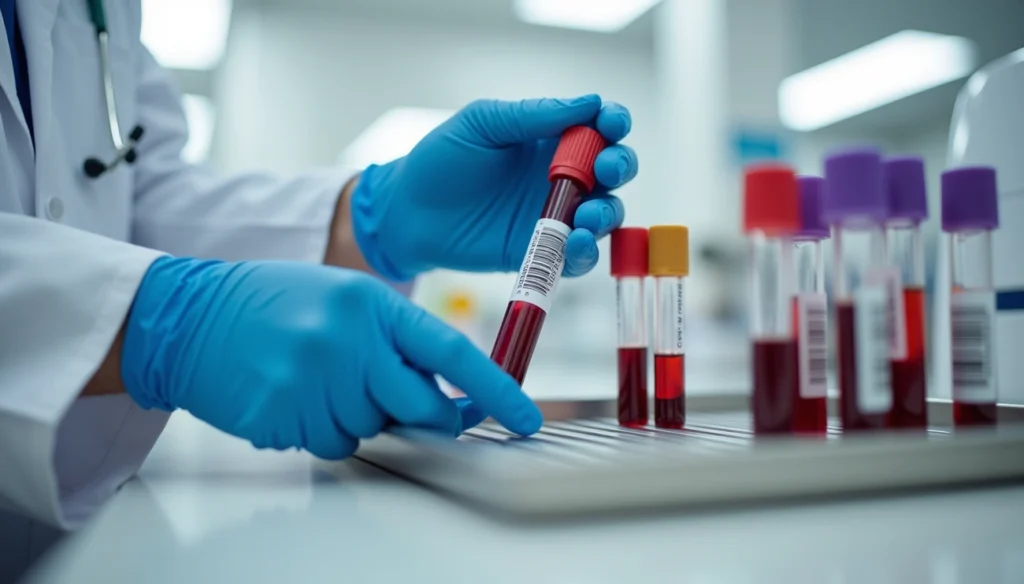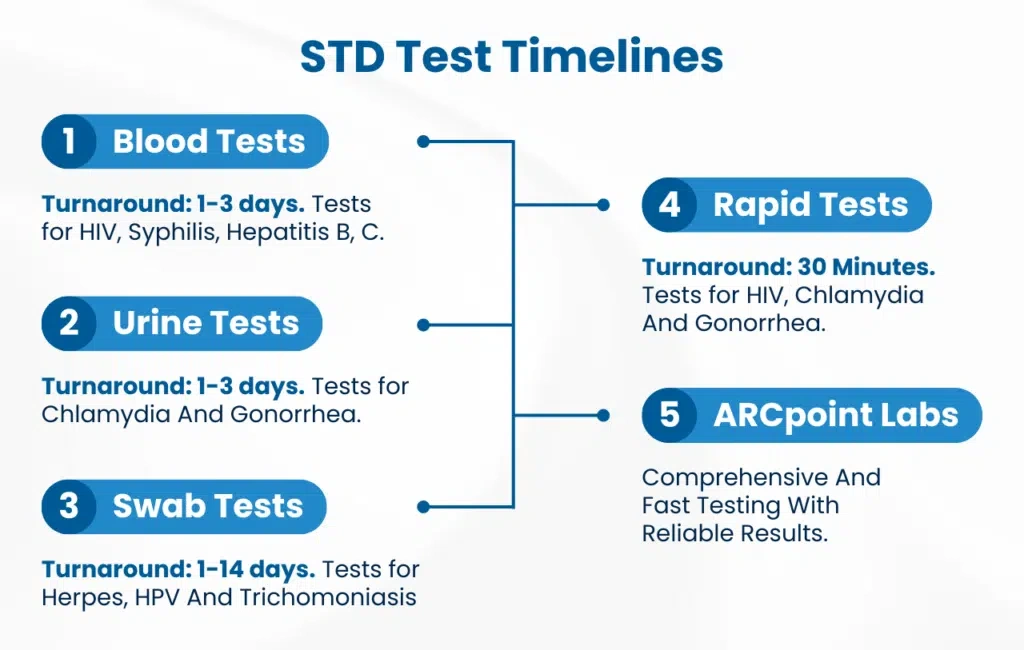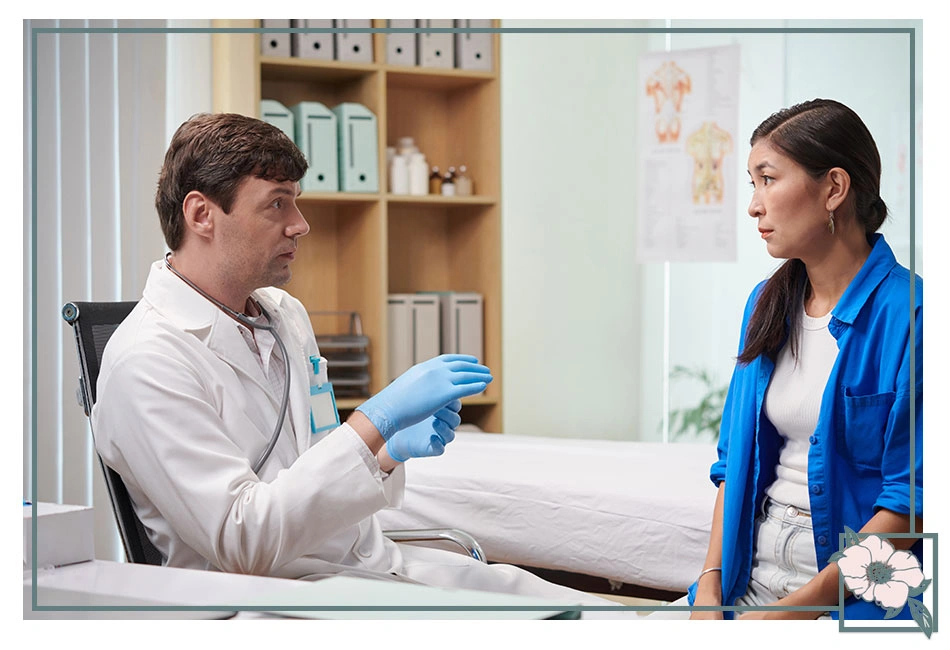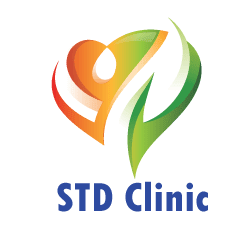STD Blood Test Detection Limits: Expert Guide to Accurate Results

Blood test screenings detect several serious infections that might slip by unnoticed. The United States sees over 25 million sexually transmitted infections yearly, and half of these affect people aged 15-24. Understanding what these tests can detect and their limitations is a vital part of your health, especially if you worry about exposure. Blood tests can identify HIV, syphilis, genital herpes, and hepatitis B or C. The accuracy of these tests depends by a lot on timing.
Every STD needs a specific time frame before showing up in test results. This “window period” varies by infection type. To name just one example, HIV antibody/antigen tests detect infection 18 to 45 days after exposure. Traditional antibody tests need 23 to 90 days. On top of that, infections like syphilis might take up to 90 days to appear in results. These infections can cause serious health problems if left untreated. The risks include infertility, birth defects, and death in some cases. This piece explains STD blood tests, detection windows, accuracy rates, and guides you through the testing process and follow-up care.
STDs Commonly Detected by Blood Tests
Blood tests play a vital role in detecting sexually transmitted diseases that don’t show immediate symptoms. A STD blood test spots infections by detecting antibodies, antigens, or the actual virus in your bloodstream.
HIV: Antibody/Antigen and RNA Blood Tests
HIV blood tests are available in three main types. Each type has different detection abilities. Your immune system makes HIV antibodies after infection, and antibody tests look for these in your blood. These tests can detect HIV between 23 to 90 days after exposure.
Antigen/antibody combination tests detect infection earlier. They search for both HIV antibodies and the p24 antigen protein found on the virus. These tests can spot HIV infection between 18 to 45 days after exposure. Blood drawn from a vein and tested in a lab shows infection faster than finger-prick tests.
Nucleic acid tests (NAT) provide the earliest possible detection by looking directly for the virus’s genetic material in your blood. NAT tests can spot HIV just 10 to 33 days after exposure. These tests cost more but work great to confirm recent HIV exposure or check viral loads in diagnosed patients.
Syphilis: Treponemal and Nontreponemal Blood Panels
Doctors use a two-step process with different blood tests to diagnose syphilis. Nontreponemal tests like Rapid Plasma Reagin (RPR) and Venereal Disease Research Laboratory (VDRL) check for antibodies your body makes against syphilis. These tests measure antibody levels to track the disease’s activity and how well treatment works.
Treponemal tests detect antibodies that target the syphilis-causing bacteria, Treponema pallidum. Examples include Fluorescent Treponemal Antibody Absorption (FTA-ABS) and T. pallidum Particle Agglutination (TP-PA) tests. Treponemal tests stay positive even after successful treatment, which makes them less helpful for checking treatment response or new infections.
Doctors use both test types together since neither one gives perfect accuracy alone.
Hepatitis B and C: HBsAg, HBsAb, HBcAb Markers
Hepatitis B testing uses three main tests to check different blood markers. The hepatitis B surface antigen (HBsAg) test spots active infection by finding viral proteins on the virus surface. A positive result shows you have hepatitis B and can spread it.
The hepatitis B surface antibody (anti-HBs) test looks for antibodies that show immunity from vaccination or past infection recovery. The hepatitis B core antibody (anti-HBc) test reveals any past hepatitis B infection but can’t tell if it’s current or old.
Hepatitis C testing starts with an antibody test to show past infection. About 25% of people naturally clear the virus without treatment. That’s why doctors order RNA testing after a positive antibody test to confirm active infection.
Genital Herpes: IgG and IgM Antibody Testing
Herpes blood tests find antibodies your immune system creates against the herpes simplex virus (HSV). IgG antibody tests give the most reliable results. These antibodies show up 3-4 weeks after infection and stay forever. The tests can tell the difference between HSV-1 (usually oral herpes) and HSV-2 (usually genital herpes).
Some labs run IgM antibody tests, but these aren’t as reliable for herpes diagnosis. Many think IgM points to recent infection, but both IgG and IgM herpes antibodies appear together. IgM tests also can’t reliably tell HSV-1 from HSV-2.
The CDC suggests herpes testing only for people with symptoms rather than routine screening. False positives happen too often in low-risk people. A positive test also can’t show when infection happened or if it causes current symptoms.
Understanding Detection Windows for Each STD
The right timing of an std blood test is a vital factor to get accurate results. The “window period” – the time between infection and reliable detection – changes based on the type of infection and test method. A test taken too early might show negative results even if an infection exists.
HIV: 18 to 90 Days Based on Test Type
The window period for HIV detection changes based on your test type:
- Nucleic Acid Tests (NAT) can detect HIV earliest—typically 10 to 33 days after exposure
- Antigen/antibody tests from a vein blood draw usually detect HIV within 18 to 45 days
- Antigen/antibody rapid tests using finger-stick blood need longer—18 to 90 days
- Antibody-only tests (including most rapid and self-tests) require 23 to 90 days
Fourth-generation laboratory tests have a median window period of 18 days. Half of all infections show up between 13 and 24 days after exposure. Healthcare providers recommend another test 3 months after exposure if your first result comes back negative.
Syphilis: 3 to 6 Weeks Post Exposure
Syphilis blood tests usually become positive about 3 to 6 weeks after infection. In spite of that, some tests detect infection as early as 2 weeks, while others need up to 12 weeks. Symptoms might appear before detectable antibodies develop. The primary chancre (sore) shows up around 3 weeks after exposure, with an incubation period of 10 to 90 days.
Second-stage symptoms appear 2 to 24 weeks after the primary lesion heals. Healthcare providers often suggest treatment based on known exposure, even with negative test results.
Hepatitis B: 60 to 150 Days
Hepatitis B has one of the longest detection windows among STDs. Medical experts suggest waiting 3 to 6 weeks after exposure before testing. Note that during the “window period” (6-8 months), neither the hepatitis B surface antigen (HBsAg) nor antibodies (anti-HBs) may show up. Anti-HBc IgM might be the only positive marker during this time.
This long window period makes follow-up testing significant, especially if you have known exposure but initial negative results.
Herpes: Minimum 12 Days for Antibody Detection
Your body starts producing HSV antibodies about 18 to 21 days after initial infection. The antibody levels need up to three months to become detectable.
IgG antibody tests (the most reliable type) need 2 to 6 months for accurate results. IgM tests can indicate recent infection but lack consistency since IgM antibodies might reappear during recurring episodes.
The timing of your std blood test plays a vital role in accurate diagnosis and treatment. Early testing might miss infections, while unnecessary delays can postpone needed treatment.
How Accurate Are STD Blood Tests?

Image Source: ARCpoint Labs
STD blood tests give reliable results but aren’t perfect. Medical data shows that lab-based STD tests are 95% to 99% accurate with proper execution. Several factors can affect these results.
False Negatives During Window Periods
Getting tested too early is the biggest reason for false negative results. Your bloodstream needs time to show signs of each STD:
- HIV takes 2 to 4 weeks to show up in blood tests
- Syphilis needs 3 to 6 weeks after exposure
- Hepatitis B requires 60 to 150 days to detect
False negatives happen more often than false positives, especially when tests are done during window periods. Healthcare providers often suggest another test after proper waiting time, whatever the original negative results show in high-risk cases.
Confirmatory Testing for Positive Results
A positive result usually needs verification through additional testing. This double-check method is crucial for HIV screening. Any preliminary positive (reactive) results need verification through a series of confirmatory tests.
Additional testing substantially improves the accuracy of testing procedures, bringing results close to 100%. This verification eliminates false positives that could cause needless worry or treatment.
Rapid Tests vs Lab-Based Tests Accuracy
Rapid point-of-care tests are convenient but might not be as accurate as laboratory methods. To cite an instance, fourth-generation laboratory HIV tests detect infection about one to two weeks earlier than rapid tests.
Two main factors create this difference:
- The detection method (antibodies only vs. antibodies plus antigens)
- Blood sample type (fingerprick vs. venous blood)
Rapid tests that use fingerprick blood samples need more time than laboratory tests with venous blood. So they might miss infections that lab tests would catch.
Effect of Immune Response on Antibody Detection
Your immune response directly affects how accurate tests are, since most STD blood tests look for antibodies instead of actual pathogens. These tests measure your immune system’s reaction to infection, not the infection itself.
These factors affect antibody detection:
- How each person’s immune system responds
- Suppressed immunity from medicines or conditions
- Recent vaccines that might cross-react
- Time needed for antibody production
Your immune system takes several weeks to make enough antibodies to detect after infection. This natural limitation explains why even the best tests can’t find very recent infections.
What to Expect During and After a Blood Test
Getting ready for an STD blood test is simple, and knowing what to expect can help calm your nerves. The test itself takes just minutes and follows a straightforward process.
Does STD Blood Test Require Fasting?
Here’s some good news – you won’t need to fast for most STD blood tests. You can eat and drink as usual before your appointment. This test is different from other blood work that might need you to skip meals. It’s still smart to check with your testing center first, since some specific panels might have their own requirements.
How Long Does STD Blood Test Take?
STD blood tests are quick procedures. The whole process usually takes less than 30 minutes. Your healthcare provider will draw blood from your arm’s vein with a small needle or do a finger prick. The actual blood collection needs just a few minutes to get a small vial. You might notice slight pain or bruising where the needle went in, but these signs fade away quickly.
How Long to Get STD Blood Test Results?
Your wait time depends on the test type:
- Regular lab blood tests usually take 1-3 days
- Some special tests need 5-7 days to process
- Many clinics now give quick results for certain STDs:
- HIV rapid tests show results in about 20 minutes
- Hepatitis B and C quick tests need around 15 minutes
- Syphilis rapid tests can give answers in just 10 minutes
STD Blood Test Panel Components Explained
A single blood sample can screen for several infections in an STD test panel. Common tests look for:
- HIV (checks both antibodies and sometimes antigens)
- Syphilis (through treponemal or non-treponemal tests)
- Hepatitis B and C (looks for specific viral markers)
- Herpes (finds type-specific antibodies)
Your doctor will walk you through your results when they arrive. A positive result shows you have the infection, while a negative result means the infection wasn’t found at detectable levels.
Take control of your health today. STD Private Clinic in Malaysia provides accurate and confidential STD testing. Book your appointment now and get reliable results you can count on.
When to Retest and What to Do After Results

Image Source: Southern Crescent Women’s HealthCare
Your next steps after receiving STD blood test results are vital to your ongoing health. A proper follow-up will give a successful treatment outcome and stop reinfection or spread to others.
Retesting Guidelines for High-Risk Groups
Testing again remains significant even after treatment. People who test positive for chlamydia, gonorrhea, or trichomoniasis should retest approximately 3 months after treatment. This helps detect any reinfection from partners who haven’t received treatment.
More frequent testing is recommended if you have higher risk factors—including men who have sex with men (MSM), sex workers, people with HIV, and those with multiple partners:
- Every 3-6 months with ongoing risk behaviors
- At least annually for sexually active people at first HIV evaluation
- More frequent screening for MSM “at increased risk” (every 3–6 months)
Pregnant women need special attention and should retest within the third trimester if under 25 or at increased risk.
Partner Notification and Preventive Treatment
Letting partners know about potential STD exposure is vital. Healthcare providers must report certain infections to local health departments. Three notification approaches exist:
- Self-referral: You tell partners directly
- Healthcare provider referral: Medical staff confidentially notify partners
- Contract referral: You agree to notify partners within a specific timeframe (usually 24-48 hours), then healthcare providers will contact them
Partner notification helps prevent reinfection effectively. Sexual partners from the previous 60 days need testing. Healthcare provider’s referral typically reaches more partners successfully.
Follow-Up After Positive or Negative Results
A positive result means you must complete your prescribed treatment fully. Medical experts point out that untreated or undertreated partners often lead to reinfection.
Negative results after potential exposure may need retesting due to STD window periods. Your original test might have happened too early after exposure. Any symptoms despite negative results should prompt you to ask your healthcare provider about additional testing.
Your health matters too much to leave to chance. STD Private Clinic in Malaysia offers accurate and private STD testing. Book your appointment today for results you can trust and peace of mind.
Conclusion
The accuracy of STD blood test results largely depends on proper timing and testing protocols. This piece has shown you detection windows that can vary from days to months based on specific infections. Of course, knowing these timeframes helps you decide the best time to get tested after exposure.
STD blood tests are highly accurate with 95-99% success rates if done properly at the right time. In spite of that, false negatives can occur, especially during window periods before infections reach detectable levels. This is why doctors often suggest retesting after specific intervals.
The testing process itself is straightforward. Most STD blood tests need minimal prep work and take just minutes to complete. Results usually arrive within a few days. On top of that, it’s crucial to notify partners and do follow-up testing to stop reinfection cycles.
Sexual health needs constant attention, not just one-time testing. Regular screening is vital if you have an active sex life, especially for high-risk groups. STD Private Clinic in Malaysia provides confidential, accurate testing services to give you peace of mind with trustworthy results.
This knowledge about detection windows, accuracy rates, and testing protocols helps you take charge of your sexual health confidently. Early detection guides you to quick treatment and prevents serious complications while protecting you and your partners. STD Private Clinic in Malaysia is here to support your testing needs with professional, discreet services that put your wellbeing first.
Key Takeaways
Understanding STD blood test detection limits is crucial for accurate diagnosis and effective treatment of sexually transmitted infections.
• Timing is critical: Each STD has specific detection windows – HIV (18-90 days), syphilis (3-6 weeks), hepatitis B (60-150 days), and herpes (minimum 12 days) after exposure.
• Test accuracy reaches 95-99% when performed correctly, but false negatives occur during window periods when infections haven’t reached detectable levels yet.
• Different test types offer varying detection speeds: Laboratory tests using venous blood detect infections earlier than rapid finger-prick tests.
• Retesting is essential for high-risk individuals every 3-6 months and for anyone testing positive approximately 3 months after treatment to detect reinfection.
• Partner notification and treatment prevents reinfection cycles – sexual partners from the previous 60 days should be informed and tested when exposure occurs.
The key to effective STD management lies in understanding these detection limitations and following proper testing protocols. Early detection through appropriately timed testing leads to prompt treatment, preventing serious health complications and protecting both you and your partners from transmission.
FAQs
Q1. How long after exposure should I get tested for STDs? The ideal time for testing varies by infection. For HIV, wait 18-90 days depending on the test type. Syphilis is detectable after 3-6 weeks, hepatitis B takes 60-150 days, and herpes requires at least 12 days. Testing too early may result in false negatives, so consult your healthcare provider for the best timing.
Q2. What’s the accuracy rate of STD blood tests? STD blood tests are generally 95-99% accurate when performed correctly. However, false negatives can occur, especially during window periods when infections haven’t reached detectable levels. Laboratory tests using venous blood typically detect infections earlier than rapid finger-prick tests.
Q3. How long does it take to get STD blood test results? Result timeframes vary based on the test type. Standard laboratory blood tests typically deliver results in 1-3 days. Some specialized tests may require 5-7 days for processing. Rapid testing options for certain STDs, like HIV, can provide results in as little as 20 minutes.
Q4. Do I need to fast before an STD blood test? Most STD blood tests do not require fasting. You can typically eat and drink normally before your appointment. However, it’s always best to confirm with your testing center beforehand, as specific panels might occasionally have different requirements.
Q5. How often should high-risk individuals get retested for STDs? High-risk individuals, such as men who have sex with men, sex workers, people with HIV, and those with multiple partners, should get retested every 3-6 months. Anyone who tests positive for certain STDs should retest approximately 3 months after treatment to check for potential reinfection.
